TACF
This chapter describes the key features of the [TACF] menu in OpenFrame Manager.
1. Overview
[TACF] provides a set of management functions provided by OpenFrame TACF system in an intuitive GUI. This includes management of users, privileges, and resources.
Click [TACF] at the top, and then click a menu from the left navigation pane to access the TACF Manager.
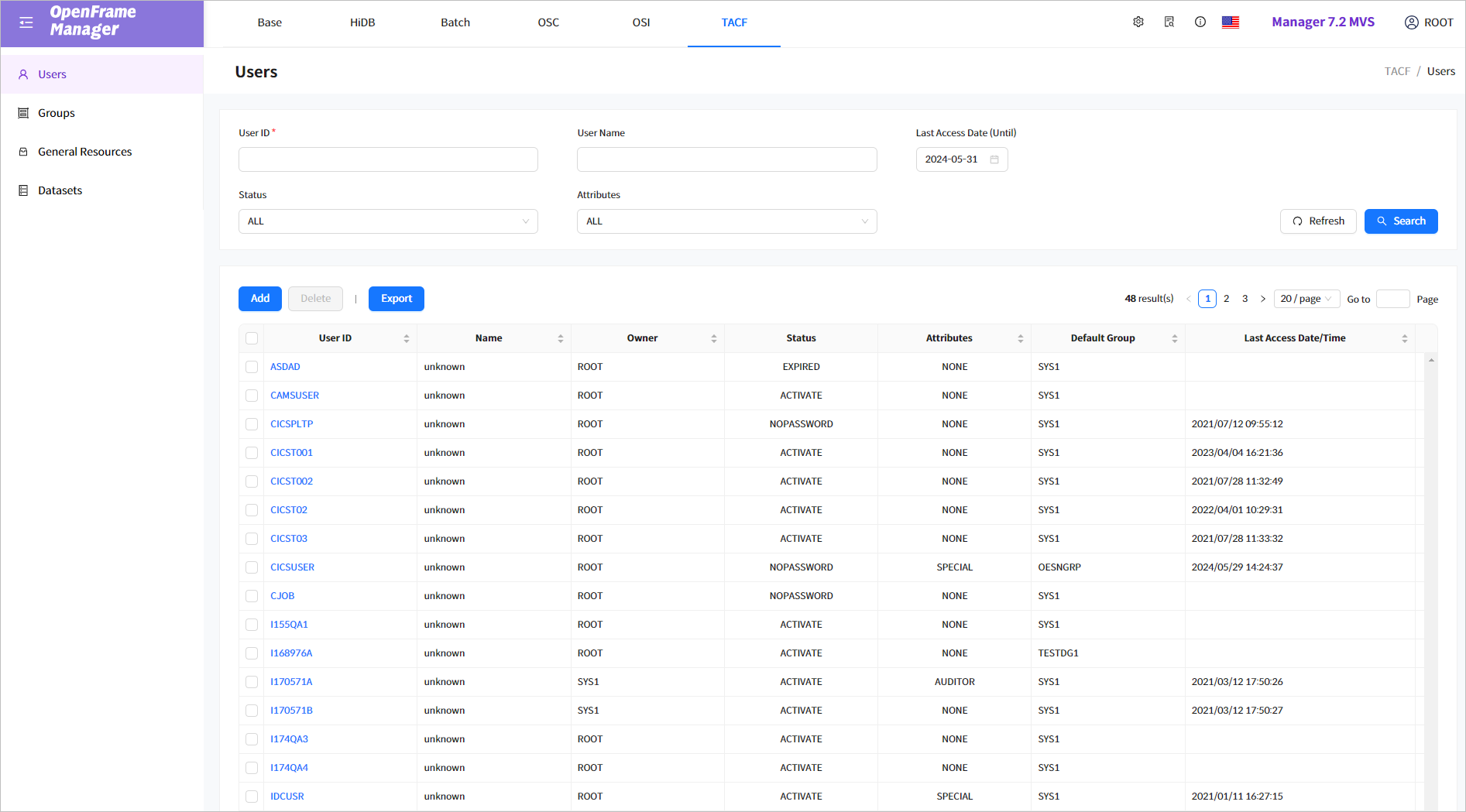
The following describes the menus in the navigation pane.
| Menu | Description |
|---|---|
Add, edit, delete, or view users in TACF. To enable permission check for the [Users] menu, set the UACC of TM.USER resource in the OFMANAGR class of TACF to NONE. Then, add Access Authority of read or higher to the access list of the resource. Only authorized users of the TM.USER resource will see the menu. |
|
Add, edit, delete, or view user groups in TACF. To enable permission check for the [Groups] menu, set the UACC of TM.GROUP resource in the OFMANAGR class of TACF to NONE. Then, add Access Authority of read or higher to the access list of the resource. Only authorized groups of the TM.GROUP resource will see the menu. |
|
Add, edit, delete, or view general resources in TACF. To enable permission check for the [General Resources] menu, set the UACC of TM.RESOURCE resource in the OFMANAGR class of TACF to NONE. Then, add Access Authority of read or higher to the access list of the resource. Only authorized users of the TM.RESOURCE resource will see the menu. |
|
Add, edit, delete, or view dataset resources in TACF. To enable permission check for the [Datasets] menu, set the UACC of TM.DATASET resource in the OFMANAGR class of TACF to NONE. Then, add Access Authority of read or higher to the access list of the resource. Only authorized users of the TM.DATASET resource will see the menu. |
|
For more information about the aforementioned items in TACF, refer to OpenFrame TACF Administrator’s Guide. |
2. Users
Click [Users] from the navigation pane to go to the Users page that displays information about all users in the TACF system. You can view, add, edit, or delete a user.
To display users registered in the TACF system, enter the search conditions and then click [Search]. If no conditions are specified, all users are displayed. To refresh the list, click [Refresh]. To add a user, click [Add]. For more information, refer to Adding a User.
To download the user list as an Excel file, click [Export]. If you click [Export] after searching users, the list of displayed users is downloaded.
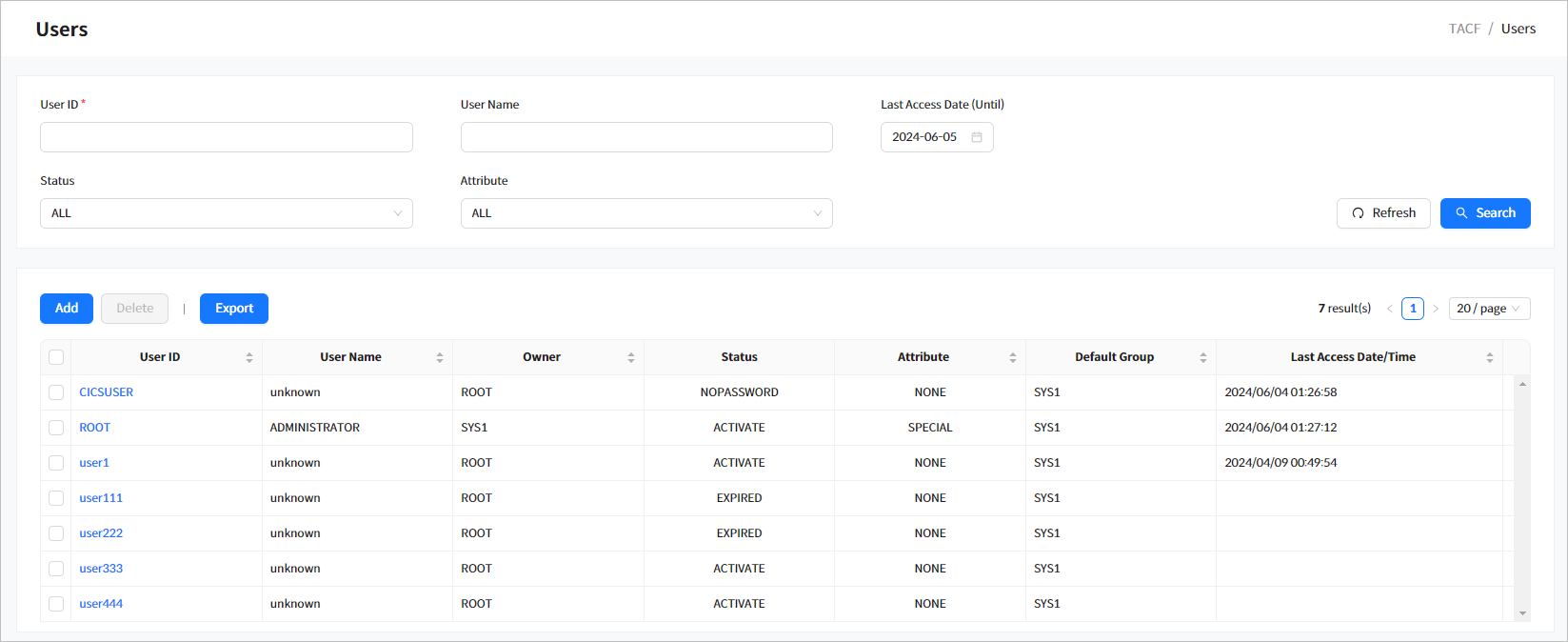
-
Search Conditions
The following describes the user search conditions.
Item Description User ID
User ID. (Up to 8 characters)
An asterisk (*) can be used (using LIKE operator).
User Name
User name. (Up to 31 characters)
Status
User account status. Select ALL to retrieve all users.
Attributes
User attribute. Select ALL to retrieve all users.
Last Access Date (Until)
Searches for all users who have logged in up to the specified date (starting from a set base date). If this is not specified, it is set to the day after the current date, and all users are retrieved regardless of the last access date.
-
Search Results
The following describes the search result columns.
Column Description User ID
TACF User ID.
Click this to go to the User Details page ([TACF] - Users - User Details). For more information, refer to User Details.
User Name
User name.
Owner
Profile owner (user ID or group name).
Attribute
User attribute.
The sort order of attributes is as follows:
-
NONE
-
SPECIAL
-
AUDITOR
-
OPERATIONS
-
RESTRICTED
Status
User account status.
-
ACTIVATE
-
REVOKED
-
LOCKED
-
NOPASSWORD
-
EXPIRED
Default Group
Default group that the user belongs to.
Last Access Date/Time
Last date/time when the user accessed the system.
-
2.1. User Details
Click a user ID from the user list in the Users page ([TACF] - Users) to go to the User Details page. Click the [<] icon before the page title to return to the previous page.
The User Details page consists of the User Information, CICS, Connected Groups, General Resources, and Dataset sections. To edit a user, click [Edit]. To delete a user, click [Delete]. For more information, refer to Editing a User and Deleting a User.
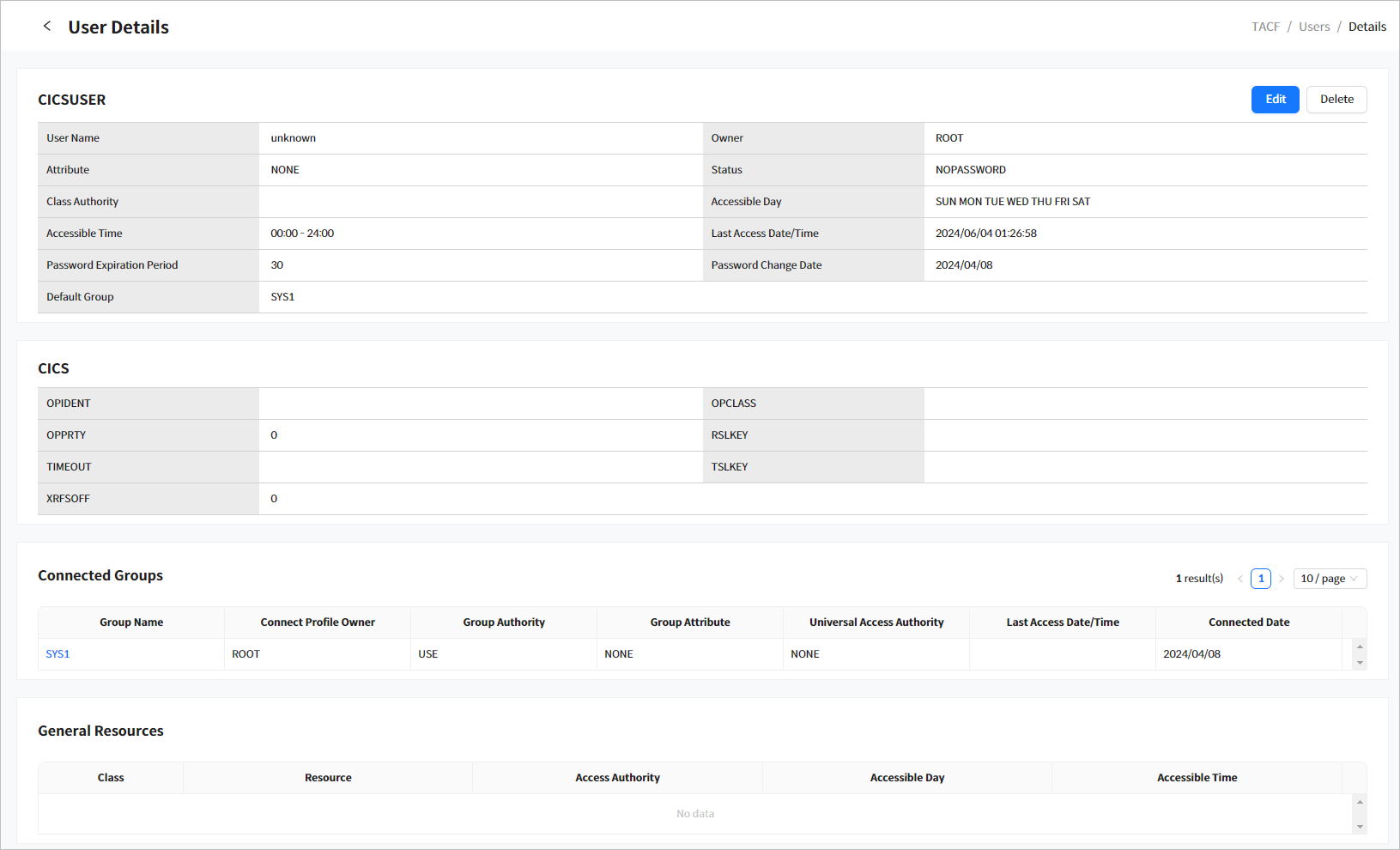
-
User Information
Item Description User Name
User name.
Status
User account status.
-
ACTIVATE
-
REVOKED
-
LOCKED
-
NOPASSWORD
-
EXPIRED
Attribute
User attribute.
-
NONE
-
SPECIAL
-
AUDITOR
-
OPERATIONS
-
RESTRICTED
Class Authority
Classes in which the user can define profiles.
Accessible Day
Days of the week when the user can access the system.
Accessible Time
Time period when the user can access the system.
Owner
Profile owner (user ID or group name).
Last Access Date/Time
Last date/time when the user accessed the system.
Password Expiration Period
Period after which password expires.
Password Change Date
Date when the password last changed.
Default Group
Default group that the user belongs to.
-
-
CICS
Item Description OPIDENT
User ID used in Basic Mapping Support (BMS).
OPCLASS
Class for routing BMS messages.
OPPRTY
Priority of the CICS terminal user.
RSLKEY
Resource Security Level (RSL) key to specify to the CICS terminal user.
TIMEOUT
Login timeout of the CICS terminal user.
TSLKEY
Transaction Security Level (TSL) key to specify to the CICS terminal user.
XRFSOFF
Option to log off the CICS terminal administrator when an XRF takeover occurs.
-
Connected Groups
Column Description Group Name
Group name.
Click this to go to the Group Details page ([TACF] - Groups - Group Details). For more information, refer to Adding a Group.
Connect Profile Owner
Profile owner (user ID or group name).
Group Authority
User’s group authority.
Group Attribute
User’s group attribute (same as the ATTR value in the user profile).
The sort order of attributes is as follows:
-
NONE
-
SPECIAL
-
AUDITOR
-
OPERATIONS
-
RESTRICTED
Universal Access Authority
Universal Access Authority for resources created under this group.
Last Access Date/Time
Last date/time when the user accessed the system under this group.
Connected Date
Date/time when the user joined the group.
-
-
General Resources
Column Description Class
Resource class name.
Resource
Resource name.
Click this to go to the Resource Details page ([TACF] - General Resources). For more information, refer to Adding a General Resource.
Access Authority
Access authority of the resource.
Accessible Day
Days of the week when the user can access the resource.
Accessible Time
Time period when the user can access the resource.
-
Datasets
Column Description Volume
Volume information of the dataset
Dataset
Dataset name.
Click this to go to the Datasets Details page ([TACF] - Datasets - Dataset Details). For more information, refer to Adding a Dataset Profile.
Access Authority
Access authority of the dataset
Accessible Day
Days of the week when the user can access the dataset.
Accessible Time
Time period when the user can access the dataset.
2.2. Adding a User
To add a user, click [Add] above the user list in the Users page ([TACF] - Users). This opens the Add User Profile page.
In the Add User Profile page, enter the required user and group information and click [Add] to save the user. This opens the Users Details ([TACF] - Users - User Details) page. For more information about this page, refer to User Details.
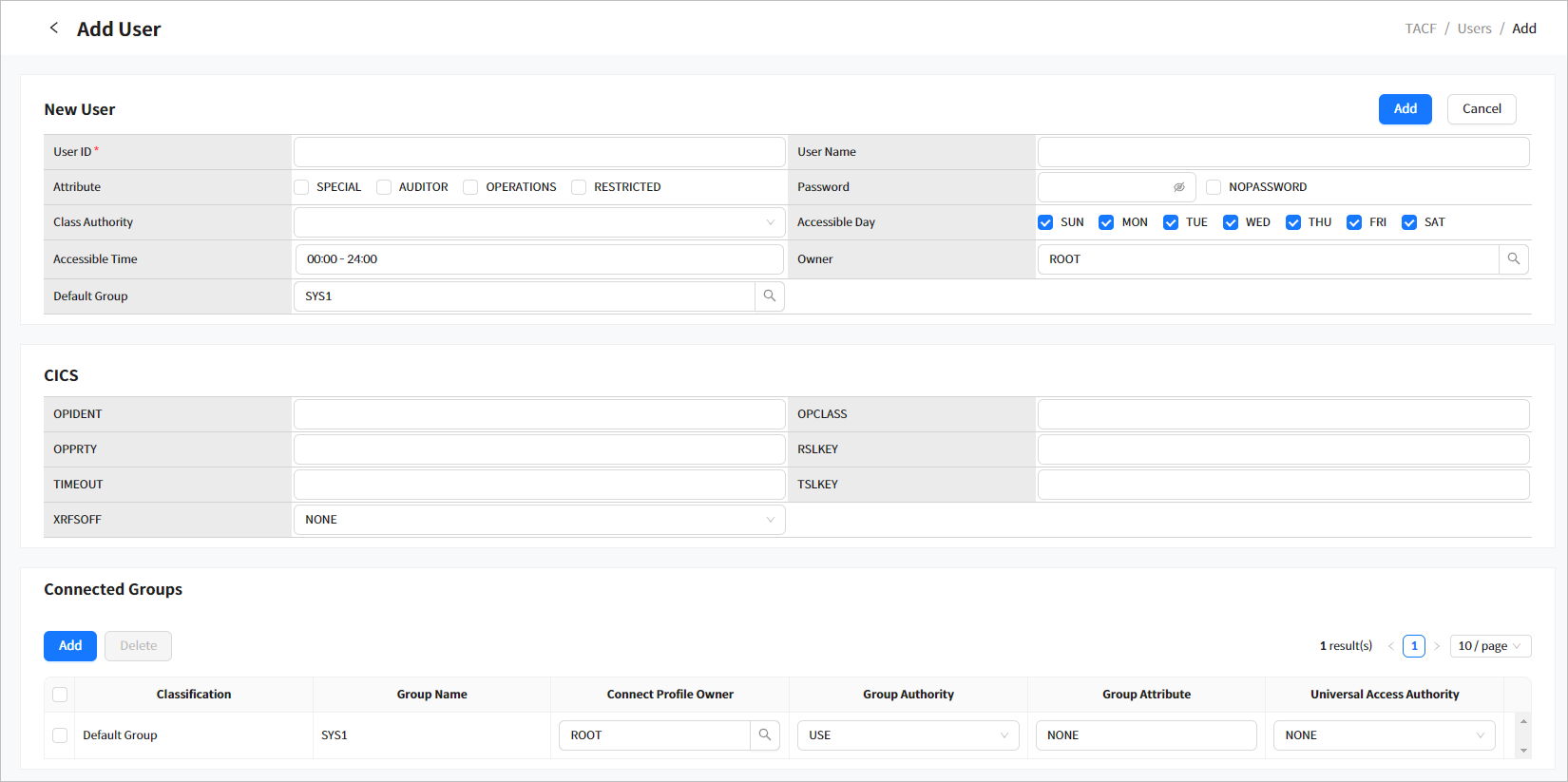
-
New User
Item Description User ID
User ID. Up to 8 alphanumeric characters and special characters (@, #, $) allowed. (Required)
User Name
User name. Up to 31 alphanumeric characters allowed.
Password
User password. If not set, the default group name of the user is used by default. For information about the password policy, refer to OpenFrame TACF Administrator’s Guide.
[Note]
If you specify the password, you must set the Status of the user to 'ACTIVATE' from the Users page after creating the user in order to log in.
Owner
Profile owner. (Default value: current logged in user)
Click
 to open the Search Owner window ([TACF] - Search Owner) to select a user ID or group name.
to open the Search Owner window ([TACF] - Search Owner) to select a user ID or group name.Attribute
User attribute.
-
NONE
-
SPECIAL
-
AUDITOR
-
OPERATIONS
-
RESTRICTED
You can set other attributes that are not listed here, but they do not provide any functionality.
Class Authority
Classes in which the user can define profiles. Selected classes are displayed at the right.
Accessible Day
Days of the week when the user can access the system.
Accessible Time
Time period when the user can access the system.
Default Group
Default group name.
Click
 ([Search]) in 'Owner' to select a user (group).
([Search]) in 'Owner' to select a user (group).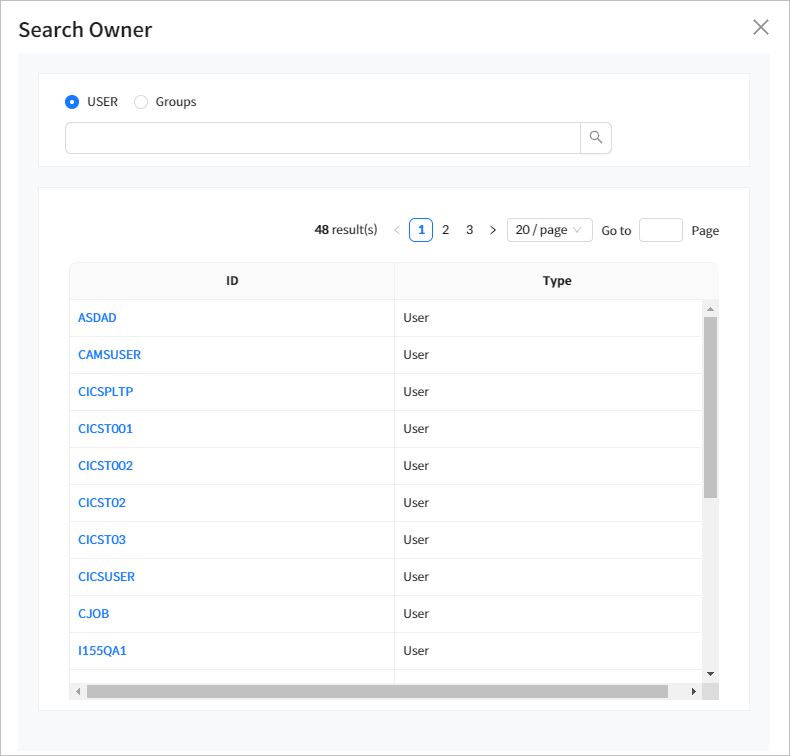 [TACF] - Search Owner
[TACF] - Search Owner -
-
CICS
Item Description OPIDENT
User ID used in Basic Mapping Support (BMS). Up to 3 characters. If not entered, a blank is displayed in the User Details page.
OPCLASS
Class for BMS messages. Enter a value between 1 and 24. Multiple values can be entered.
OPPRTY
Priority of the CICS terminal user. Enter a value between 0 and 255. (Default value: 0)
RSLKEY
Resource Security Level (RSL) key to specify to the CICS terminal user. Enter a value between 0 and 24, or 99. Multiple values can be entered. (Default value: 0)
TIMEOUT
Login timeout of the CICS terminal user in the format of m, mm, hmm, or hhmm.
TSLKEY
Transaction Security Level (TSL) key to specify to the CICS terminal user. Enter a value between 0 and 64, or 99. Multiple values can be entered. (Default value: 1)
XRFSOFF
Option to log off the CICS terminal administrator when an XRF takeover occurs.
-
FORCE: log off the administrator.
-
NOFORCE: do not log off the administrator.
-
-
Connected Groups
Information about the group to assign the user to.
Column Description Classification
Specify whether the group is the 'Default Group'.
-
Default Group: default group.
-
Additional: not a default group.
-
Input: add to the list of groups to connect to
Group Name
Group name to which the user permission is assigned. (Default value: SYS1)
Click
 to open the Search Group window ([TACF] - Add Connected Profile) to select a group name.
to open the Search Group window ([TACF] - Add Connected Profile) to select a group name.Connect Profile Owner
Connect profile owner. (Default value: currently logged in user)
Click
 to open the Add Connect Profile window ([TACF] - Search Owner) to select a user ID or group name.
to open the Add Connect Profile window ([TACF] - Search Owner) to select a user ID or group name.Group Authority
User’s group authority. (Default value: USE)
Group Attribute
User’s group attribute (same as the ATTR value in the user profile).
Default value: NONE
Universal Access Authority
Universal Access Authority for resources created by the user under this group.
Default value: NONE
Click [Add] to enter the information of a group to be connected. For more information, refer to Adding a Group.
 [TACF] - Add Connected Profile
[TACF] - Add Connected ProfileTo select the user (group) to be set, click
 ([Search]) in 'Connect Profile Owner'.
([Search]) in 'Connect Profile Owner'. [TACF] - Search Owner
[TACF] - Search OwnerTo configure the connected group information, click
 ([Search]) in 'Group Name' of the Add Connect Profile window.
([Search]) in 'Group Name' of the Add Connect Profile window.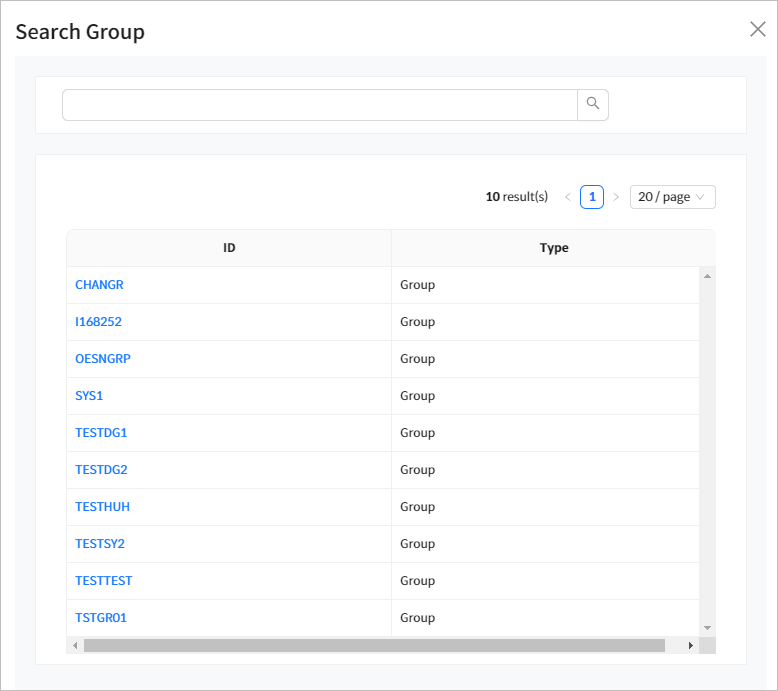 [TACF] - Search Group
[TACF] - Search Group -
2.3. Editing a User
To edit a user, select the user from the user list and then click [Edit] in the Users page ([TACF] - Users). This opens the Edit User Profile page. In the page, edit required items and click [Edit].

-
User Information
The following describes each item. For information about items that are not described in the following, refer to Adding a User.
Item Description Status
User status.
-
LOCKED (when a user entered wrong password repeatedly)
-
EXPIRED
-
NOPASSWORD
-
ACTIVATE
-
REVOKED
Password
User password. Only the user or its owner can change the password.
Password Confirm
Re-enter password.
Password Expiration Period
Password change interval. To not set the interval, select NOINTERVAL.
[Note]
If the password is changed to a previously used one, an error occurs. Users are instructed to define and use TACF password policies. It is supported through saf_exit. Invalid passwords need to be defined in INVALID_PASSWORD1 key under the [ERRCODE] section in the saf subject of the openframe_base.conf file. For more information, refer to OpenFrame Configuration Guide.
---------------------------------------------------------------------------------------------------- SUBJECT | SECTION | KEY | TYPE | DEFAULT_VALUE | VALUE ---------------------------------------------------------------------------------------------------- saf | ERRCODE | INVALID_PASSWORD1 | 2 | password length is wrong | password length is wrong
-
-
Connected Groups
Update an already assigned group, assign a new group or delete a group assignment. A connected group with Classification of "Default Group" cannot be modified. The Group Name of a connected group with Classification of "Additional" cannot be modified.
Click [Add] to add or [Delete] to delete a group assignment. For more information, refer to Adding a Group.
-
General Resources
Add or delete user’s access authority for resources.
Click [Add] to add or [Delete] to delete access authority for the resource. For more information, refer to Adding a Group.
Column Description Class
Resource class name.
Resource
Resource name.
Access Authority
Access authority of the resource.
Accessible Day
Days of the week when the user can access the resource.
Accessible Time
Time period when the user can access the resource.
-
Datasets
Add or delete user’s access authority for datasets.
Click [Add] to add or [Delete] to delete access authority for the dataset. For more information, refer to Adding a Group.
Column Description Volume
Volume information of the dataset.
Dataset
Dataset name.
Access Authority
Access authority of the dataset.
Accessible Day
Days of the week when the user can access the dataset.
Accessible Time
Time period when the user can access the dataset.
2.4. Deleting a User
To delete a user, select the user from the user list and then select [Delete] in the Users page ([TACF] - Users). When a confirmation dialog box opens, click [OK].

|
You cannot delete a user who is the owner of a resource or an administrator. |
3. Groups
Click [Groups] from the navigation pane to go to the Groups page that displays information about all groups in the TACF system. You can view, add, edit, or delete a group.
To display groups registered in the TACF system, enter Group Name as a search condition and then click [Search]. If no conditions are specified, all groups are displayed (Wildcard (*) search method). To refresh the list, click [Refresh].
To download the group list as an Excel file, click [Export]. If you click [Export] after searching users, the list of displayed users is downloaded.
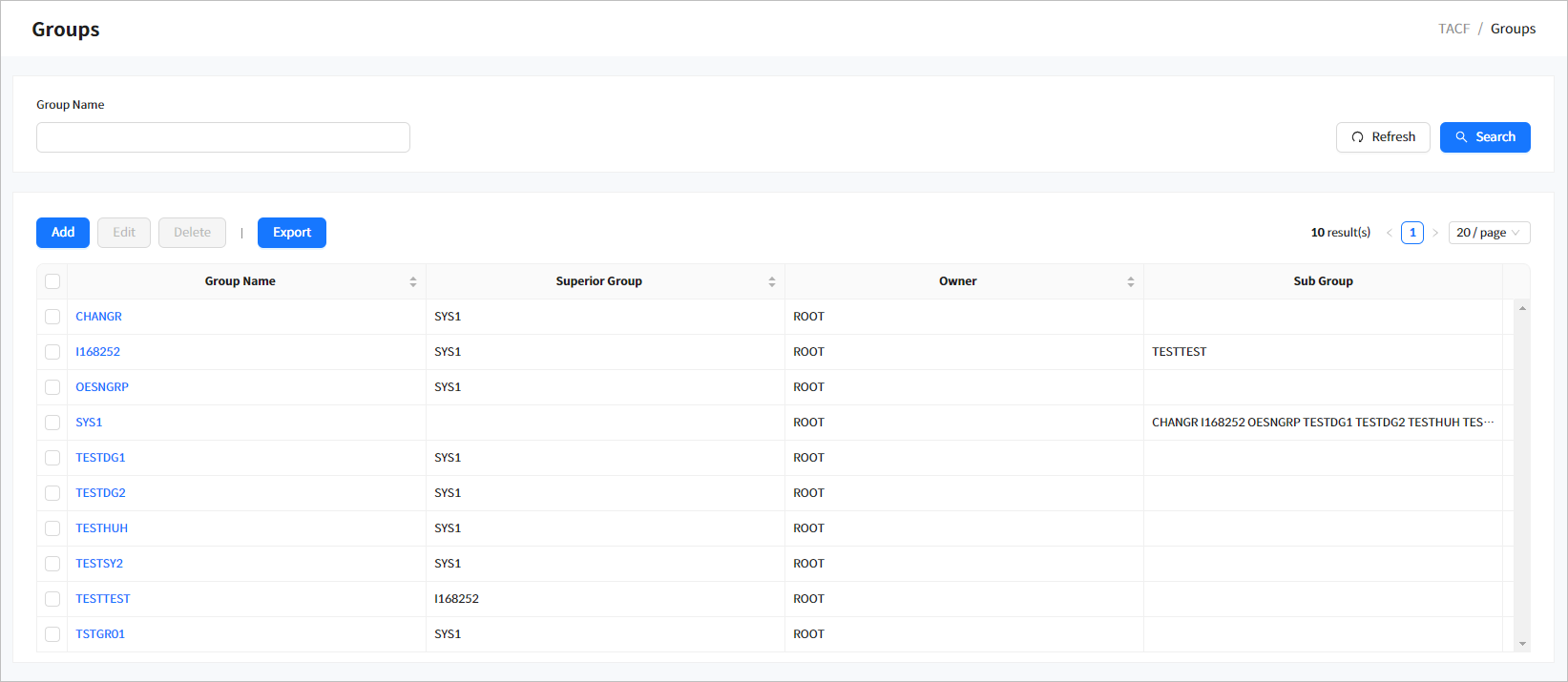
-
Search Conditions
The following describes the group search condition.
Item Description Group Name
Group name to search for (wildcards allowed).
-
Search Results
The following describes the search result columns.
Column Description Group Name
TACF group name.
Click this to go to the Group Details page ([TACF] - Groups - Group Details). For more information, refer to Group Details.
Superior Group
Parent group of the group.
Owner
Owner of the group.
Sub Group
Subgroups of the group. Place the cursor over the text to view a complete list of subgroups.
-
Buttons
The following describes each button.
Button Description [Add]
Adds a new group. For more information, refer to Adding a Group.
[Edit]
Edits a group selected from the group list. For more information, refer to Editing a Group.
[Delete]
Deletes a group selected from the group list. For more information, refer to Deleting a Group.
[Export]
Downloads the group list as an Excel file.
3.1. Group Details
Click a group name from the group list in the Groups page ([TACF] - Groups) to go to the Group Details page. Click the [<] icon to the left of the page title to return to the previous page.
The Group Details page consists of the Group Information, Connected Users, General Resources, and Datasets sections. To edit a group, click [Edit]. To delete a group, click [Delete]. For more information, refer to Editing a Group and Deleting a Group.
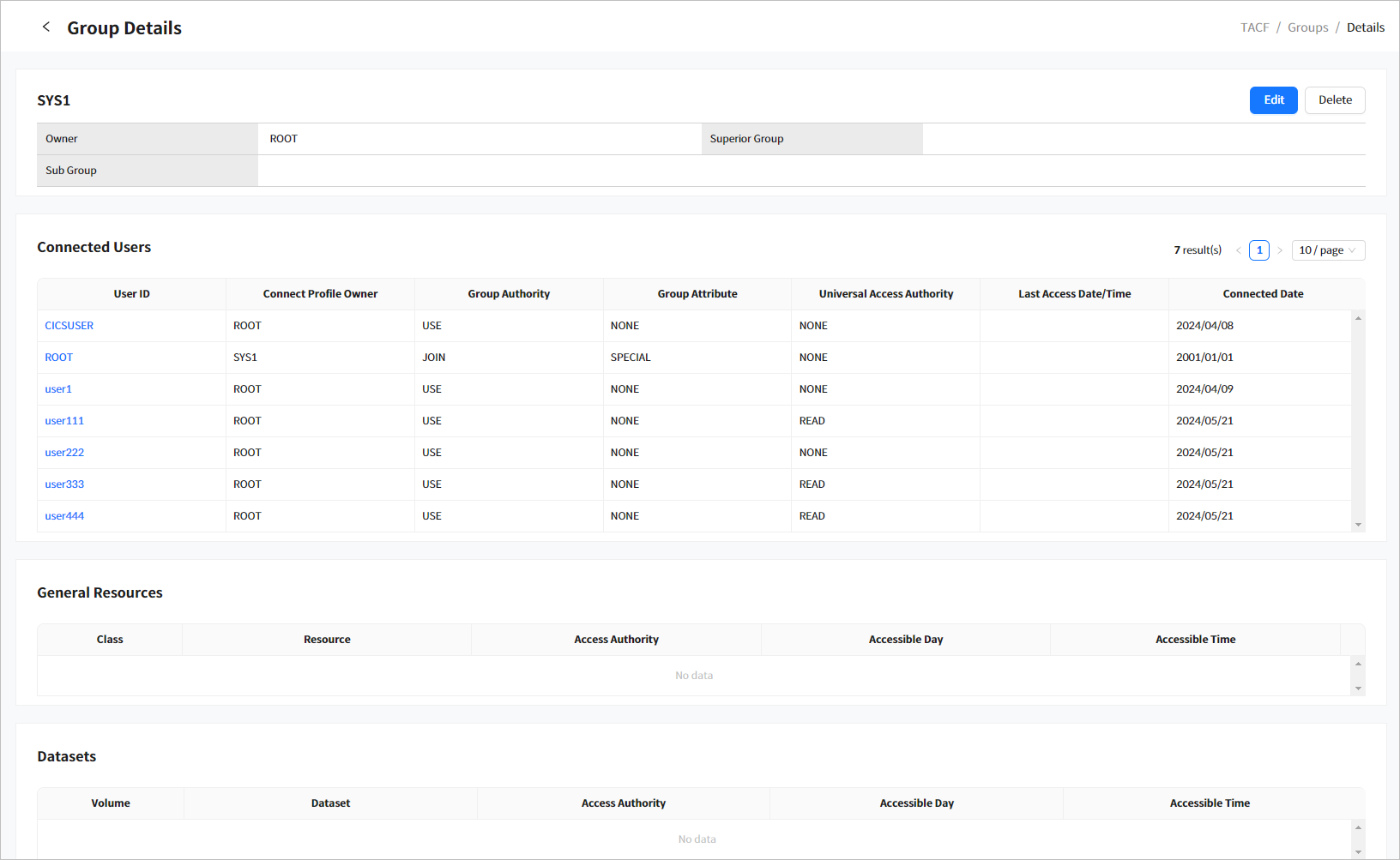
-
Group Information
Displays detailed information about the selected group.
Item Description Owner
Owner of the group.
Superior Group
Parent group of the group.
Sub Group
Subgroups of the group. Place the cursor over the text to view a complete list of subgroups.
-
Connected Users
Displays the users of the group. For more information about each column, refer to Adding a Group.
Column Description User ID
User ID.
Click this to go to the User Details page ([TACF] - Users - User Details). For more information, refer to User Details.
Connect Profile Owner
Profile owner (user ID or group name).
Group Authority
User’s group authority.
The sort order of authorities is as follows:
-
USE
-
CREATE
-
CONNECT
-
JOIN
Group Attribute
User’s group attribute (same as the ATTR value in the user profile).
The sort order of attributes is as follows:
-
NONE
-
SPECIAL
-
AUDITOR
-
OPERATIONS
-
RESTRICTED
Universal Access Authority
Universal Access Authority for resources created by the user under this group.
The sort order of universal access authorities is as follows:
-
NONE
-
EXECUTE
-
READ
-
UPDATE
-
CONTROL
-
ALTER
Last Access Date/Time
Last date/time when the user accessed the system under this group.
Connected Date
Date/time when the user joined the group.
-
-
General Resources
View a list of resources that the group can access. For more information, refer to User Details.
-
Datasets
View a list of datasets that the group can access. For more information, refer to User Details.
3.2. Adding a Group
To add a group, click [Add] above the group list in the Groups page ([TACF] - Groups). This opens the Add Group page. In the page, enter the required group information, register users, and then click [Add] to add the users to the group.

-
Group Information
The following describes each item.
Item Description Group Name
Group name. Up to 8 alphanumeric characters and special characters (@, #, $) allowed. (Required)
Owner
Group owner. Click
 to open the Search Owner window ([TACF] - Search Owner) to select a user ID or group name.
to open the Search Owner window ([TACF] - Search Owner) to select a user ID or group name.Superior Group
Parent group of the group. Click
 to open the Search Group window ([TACF] - Add Connected Profile) to select a group name.
to open the Search Group window ([TACF] - Add Connected Profile) to select a group name. -
Connected Users
Click [Add] to add users to the group or [Delete] to delete users from the group. For more information, refer to Adding a User.
3.3. Editing a Group
To edit a group, select the group from the group list and then click [Edit] in the Groups page ([TACF] - Groups), or click [Edit] at the top right of the Groups Details page ([TACF] - Groups - Group Details). This opens the Edit Group page.
In the page, you can edit the group information, add, edit, or delete users of the group, or add or delete resource and dataset authorities of the group. Click [Save] to save the changes. For more information, refer to Adding a Group and Adding a User.
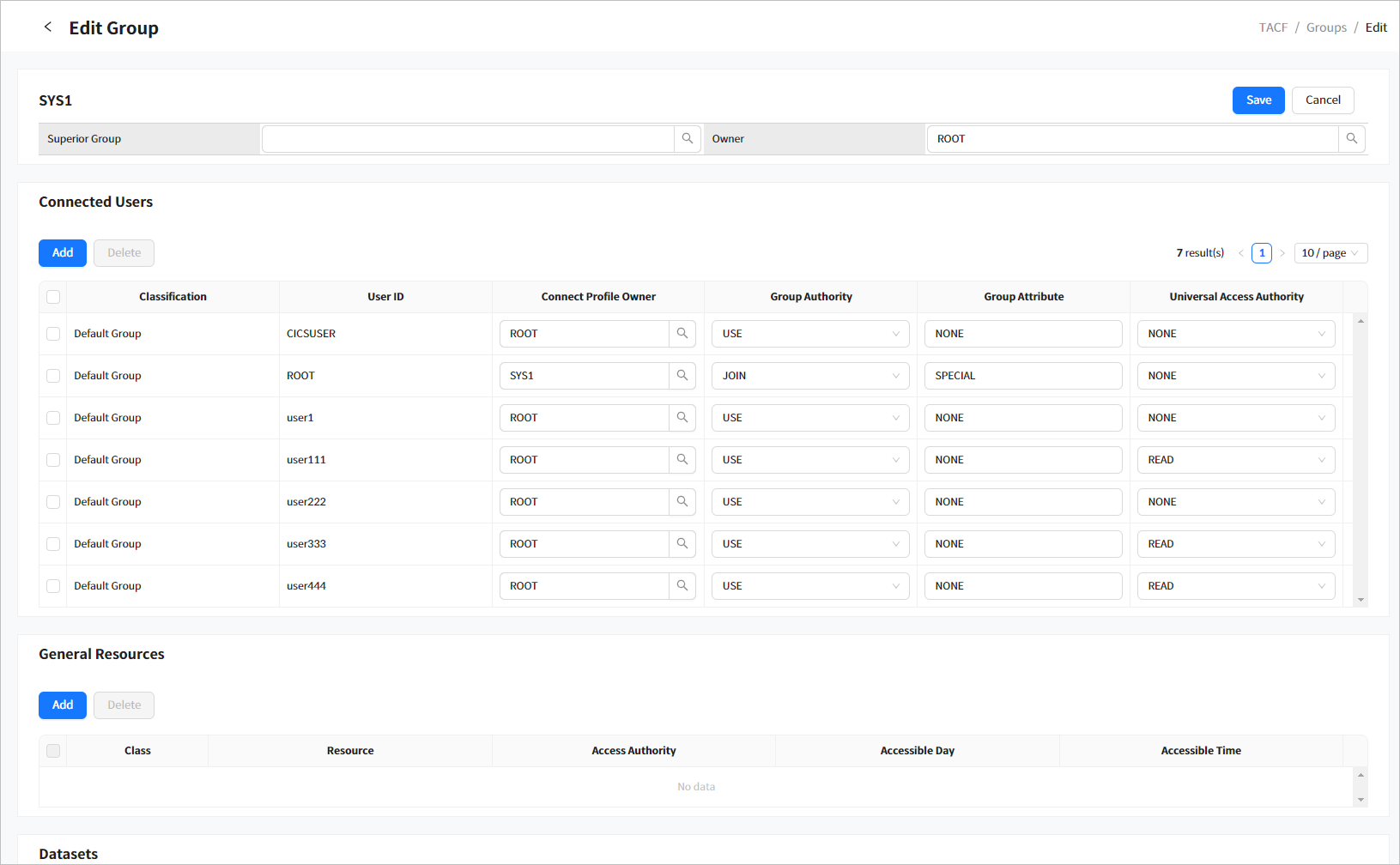
|
In the Edit mode, some items of the root group cannot be edited. |
3.4. Deleting a Group
To delete a group, select the group from the group list and click [Delete] in the Groups page ([TACF] - Groups), or click [Delete] at the top right of the Groups Details page ([TACF] - Groups - Group Details). When a confirmation dialog box opens, click [OK].
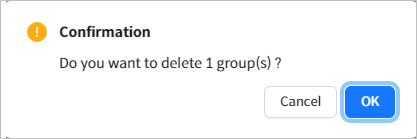
|
A superior group to other groups or a default group of a user cannot be deleted. |
4. General Resources
General resources and dataset resources can be registered in TACF system.
Click [General Resources] from the navigation pane to go to the General Resources page that displays information about general resources. You can view, add, edit, or delete a resource.
Classes registered in TACF are displayed in the left pane. Clicking one of the classes displays its resources. Initially, the first class is selected and its resources are displayed. To view a resource, enter the resource name and click [Search]. If no keyword is specified, all resources are displayed (Exact search method). To refresh the list, click [Refresh].
To add a resource, click [Add] above the resource list. For more information, refer to Adding a General Resource. To edit a resource, select the resource and click [Edit]. For more information, refer to Editing a General Resource. To delete a resource, select the resource and click [Delete]. For more information, refer to Deleting a General Resource. To download the resource list as an Excel file, click [Export]. If you click [Export] after searching resources, the list of displayed resources is downloaded.
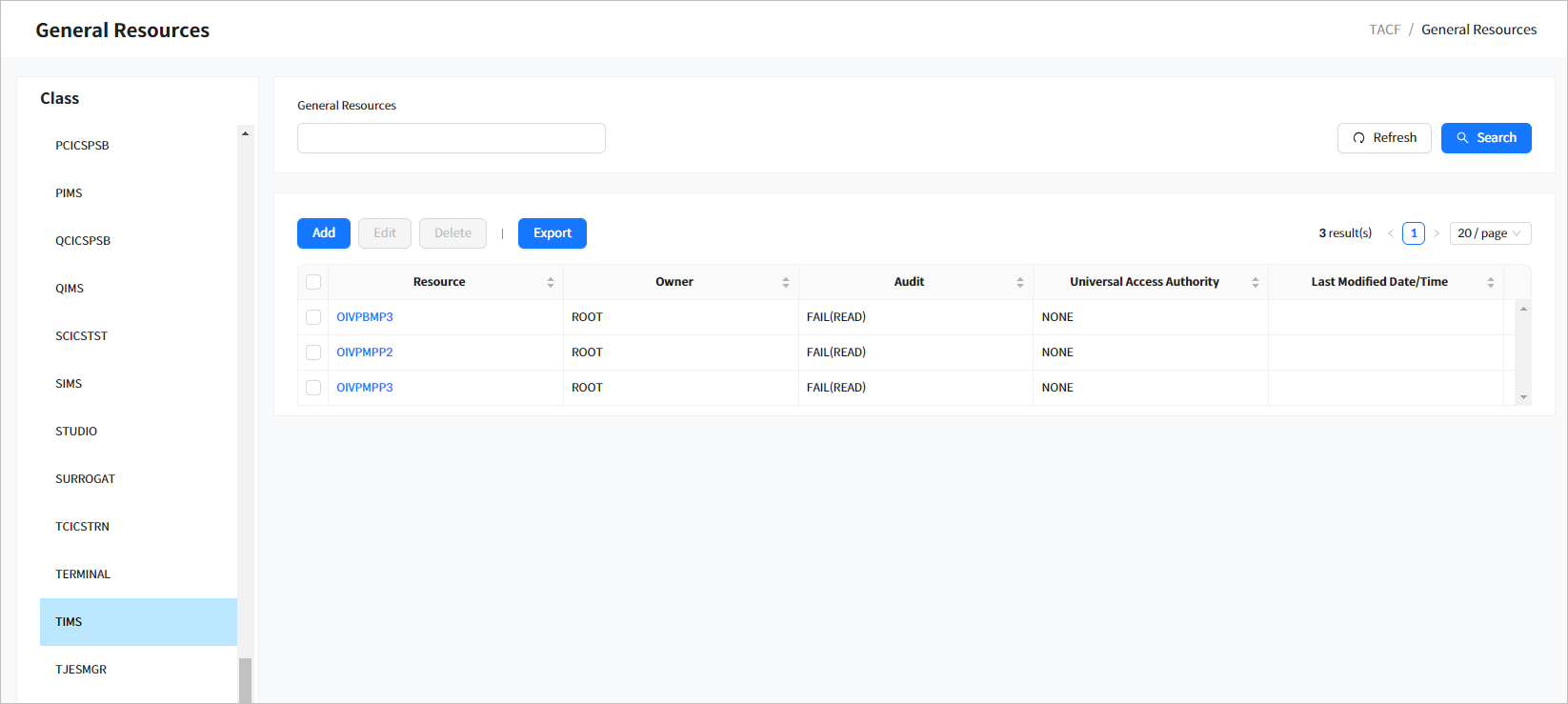
-
Class list
Displays classes registered in TACF.
-
Resource list
-
Search Conditions
The following describes the resource search conditions.
Item Description General Resources
Resource name. (LIKE (prefix) search method)
-
Search Results
The following describes the search result columns.
Column Description Resource
Resource profile name.
Owner
Owner ID or group name of the profile.
Audit
Audit level for resource access.
Universal Access Authority
Universal Access Authority for the resource.
Last Modified Date/Time
Last date/time the resource was modified.
-
|
Permissions for resources can be checked by using the default resource class defined in TACF. For more information, refer to OpenFrame TACF guides. |
4.1. General Resource Details
Click a resource name from the resource list in the General Resources page ([TACF] - General Resources) to go to the General Resource Details page. Click the [<] icon to the left of the page title to return to the previous page.
The General Resources Details page consists of the Resource Information and Access List sections. To edit a resource, click [Edit]. To delete a resource, click [Delete]. For more information, refer to Editing a General Resource and Deleting a General Resource.

-
Resource Information
Displays detailed information about a resource. For more information, refer to Adding a General Resource.
-
Access List
Displays users and groups that have an authority for the resource.
Item Description Classification
Either User or Group.
ID
User ID or group name.
Access Authority
Access authority level for the resource.
Accessible Day
Days of the week when the resource is accessible.
Accessible Time
Time when the resource is accessible.
4.2. Adding a General Resource
To add a resource, click [Add] above the resource list in the General Resources page ([TACF] - General Resources). This opens the Add General Resource Profile page. In the page, enter the required resource information, add users and groups that have access authority for the resource, and then click [Add] to save the resource.

-
Resource Information
The following describes each item.
Item Description Resource Name
Resource profile name. (Required)
Allowed characters for a general profile are alphanumeric and special characters (‘%’, ‘*’, ‘**’, and ‘***’).
Class Name
Class of the profile. (Required)
Owner
Profile owner (user ID or group name). (Default value: user ID that created the profile)
The profile owner can access, edit or delete the profile.
Audit
Audit level for resource access.
-
FAIL(READ): failed read will log an audit record.
-
FAIL(UPDATE): failed read, update, write, or copy will log an audit record.
-
FAIL(CONTROL): used to prevent error.
-
FAIL(ALTER): failed read, update, delete, rename, move, or scratch will log an audit record.
-
SUCCESS(READ): successful read will log an audit record.
-
SUCCESS(UPDATE): successful update, read, write, or copy will log an audit record.
-
SUCCESS(CONTROL): used to prevent error.
-
SUCCESS(ALTER): successful read, update, delete, rename, move, or scratch will log an audit record.
Universal Access Authority
Universal Access Authority for the resource.
-
NONE: no authority. (Default value)
-
EXECUTE: allows execute access.
-
READ: allows read access.
-
UPDATE: allows read, copy, or write access (no delete or move access).
-
CONTROL: allows control interval access on VSAM, and retrieve, update, insert, and delete accesses on the resource. Same as UPDATE for non-VSAM. (Unsupported in the current version)
-
ALTER: allows alter access to change the resource name.
-
-
Access List
Displays users and groups that have an authority for the resource. For more information about each item, refer to General Resource Details. To add a resource, click [Add] and enter required items in the following Add Permit dialog.
 [TACF] - General Resources - Add General Resource Profile - Add Permit
[TACF] - General Resources - Add General Resource Profile - Add Permit
4.3. Editing a General Resource
To edit a resource, select the resource from the resource list and click [Edit] in the General Resources page ([TACF] - General Resources). This opens the Edit General Resource Profile page. In the page, edit required items and click [Edit]. For more information about each item, refer to Adding a General Resource.

|
To view profile changes in detail, set the level of "com.tmax.ofmanager" in the logback.xml file to "TRACE". |
4.4. Deleting a General Resource
To delete a resource, select the resource from the resource list and then click [Delete] in the General Resources page ([TACF] - General Resources). When a confirmation dialog box opens, click [OK].

|
A general resource with assigned users or groups cannot be deleted. |
5. Datasets
Click [Datasets] from the navigation pane to go to the Datasets page that displays dataset profiles registered in the TACF system. You can view, add, edit, or delete a dataset profile.
To display datasets registered in the TACF system, enter the search conditions and then click [Search]. If no conditions are specified, all datasets are displayed. To refresh the list, click [Refresh].
To add a dataset resource, click [Add]. For more information, refer to Adding a Dataset Profile. To edit a dataset profile, select the dataset from the dataset list and click [Edit]. For more information, refer to Editing a Dataset Profile. To delete a dataset profile, select the dataset from the dataset list and click [Delete]. For more information, refer to Deleting a Dataset Profile. To download the dataset list as an Excel file, click [Export]. If you click [Export] after searching datasets, the list of displayed datasets is downloaded.
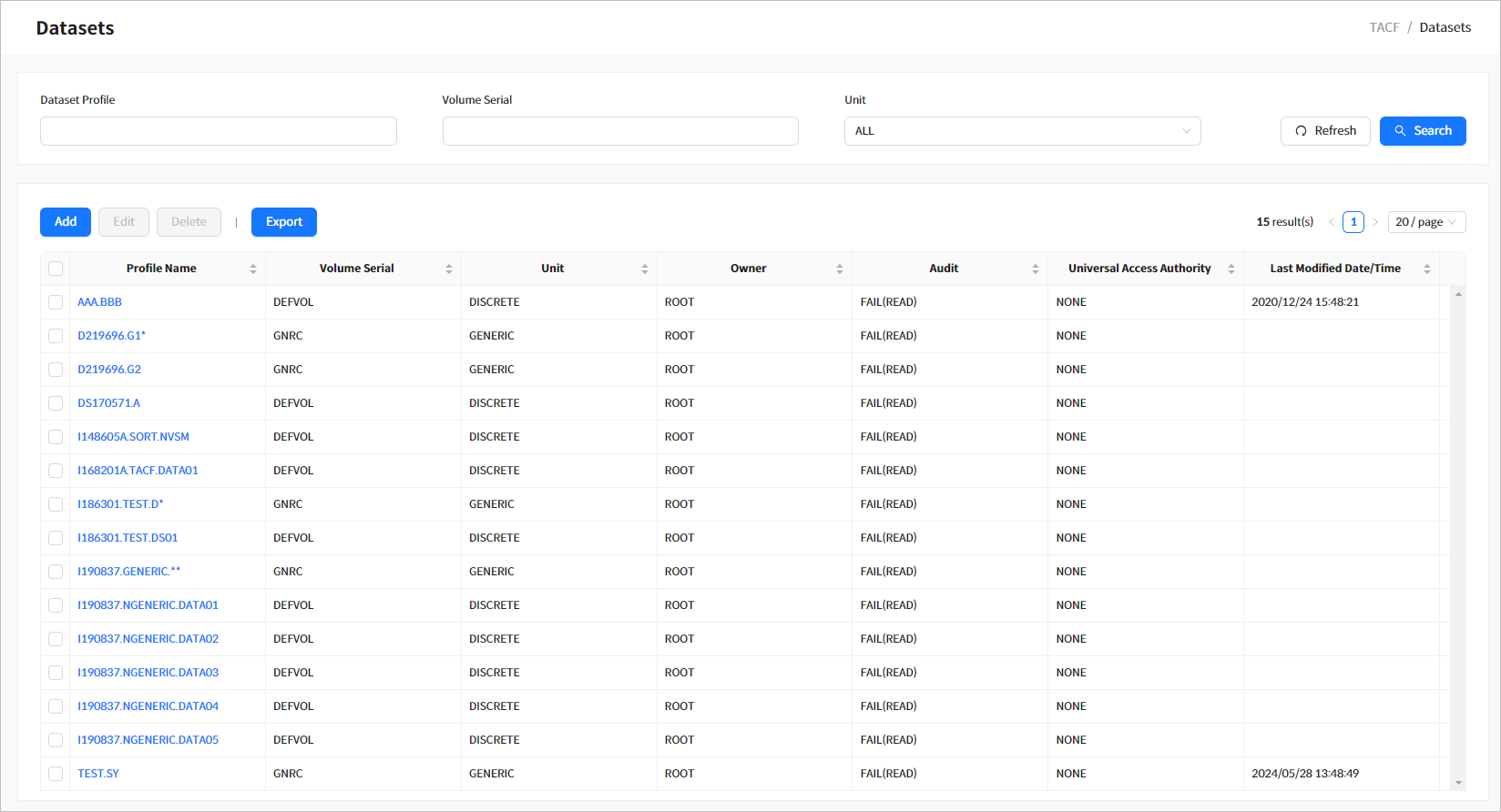
-
Search Conditions
The following describes the dataset profile search conditions.
Item Description Dataset Profile
Dataset profile name.
Volume Serial
Volume serial name for the dataset.
Unit
Dataset profile type. Select ALL to retrieve all profiles.
-
Search Results
The following describes the search result columns. For more information, refer to Dataset Details.
Column Description Profile Name
Dataset profile name.
Click this to go to the Dataset Resource Details page ([TACF] - Datasets - Dataset Details). For more information, refer to Dataset Details.
Volume Serial
Volume serial name for the dataset.
Unit
Dataset profile type.
Owner
Profile owner (user ID or group name).
Audit
Audit level for accessing the dataset.
The sort order of audit levels is as follows (uses universal access authority as secondary sort order):
-
FAIL
-
SUCCESS
-
ALL
Universal Access Authority
Universal Access Authority for dataset resource.
The sort order of universal access authorities is as follows:
-
NONE
-
EXECUTE
-
READ
-
UPDATE
-
CONTROL
-
ALTER
Last Modified Date/Time
Last date/time the profile was modified.
-
|
For more information, refer to "4.3. Data Set Profiles" section in OpenFrame TACF Administrator’s Guide. |
5.1. Dataset Details
Click a profile name from the dataset list in the Datasets page ([TACF] - Datasets) to go to the Dataset Details page. Click the [<] icon before the page title to return to the previous page.
The Dataset Details page consists of the Dataset Profile Information and Access List sections. To edit a dataset, click [Edit]. To delete a dataset, click [Delete]. For more information, refer to Editing a Dataset Profile and Deleting a Dataset Profile.

-
Dataset Profile Information
The following describes each item. For more information about each item, refer to Adding a Dataset Profile.
Item Description Profile Name
Dataset profile name. Datasets in TACF have a unique profile name.
Volume Serial
Volume serial name for the dataset.
Owner
Profile owner (user ID or group name).
Unit
Dataset profile type.
Audit
Audit level for dataset access.
Universal Access Authority
Universal Access Authority for the dataset.
Last Modified Date/Time
Last date/time the profile was modified.
-
Access List
5.2. Adding a Dataset Profile
To add a dataset profile, click [Add] above the dataset list in the Datasets page ([TACF] - Datasets). This opens the Add Dataset Profile page. In the page, enter the required dataset information, add users and groups, and then click [Add] to save the dataset.

-
Dataset Information
The following describes each item.
Item Description Dataset Profile
Dataset profile name. (Required)
Allowed characters for a general profile are alphanumeric and special characters (‘%’, ‘*’, ‘**’, and ‘***’). For more information, refer to "4.1.2 Creating Generic Data Set Profiles" in OpenFrame TACF Administrator’s Guide.
Volume Serial
Volume serial name for the dataset.
Owner
Profile owner (user ID or group name).
The profile owner can access, update, or delete the profile.
Unit
Dataset profile type.
-
DISCRETE (Default value)
-
GENERIC
-
MODEL
-
TAPE
Universal Access Authority
Universal Access Authority for the dataset.
-
NONE: no authority. (Default value)
-
EXECUTE: allows execute access.
-
ALTER: allows alter access to change the dataset name.
-
READ: allows read access.
-
UPDATE: allows read, copy, or write access (no delete or move access).
-
CONTROL: allows control interval access on VSAM, and retrieve, update, insert, and delete accesses on the resource. Same authority as UPDATE for non-VSAM. (Not supported in the current TACF version)
Audit
Audit level for dataset access.
-
FAIL(READ): failed read will log an audit record.
-
FAIL(UPDATE): failed read, update, write, or copy will log an audit record.
-
FAIL(CONTROL): used to prevent error.
-
FAIL(ALTER): failed read, update, delete, rename, move, or scratch will log an audit record.
-
SUCCESS(READ): successful read will log an audit record.
-
SUCCESS(UPDATE): successful update, read, write, or copy will log an audit record.
-
SUCCESS(CONTROL): used to prevent error.
-
SUCCESS(ALTER): successful read, update, delete, rename, move, or scratch will log an audit record.
-
-
Access List
Displays users and groups that have access authority for the dataset profile. For more information, refer to General Resource Details.
5.3. Editing a Dataset Profile
To edit a dataset profile, select the dataset from the dataset list and click [Edit] in the Dataset page ([TACF] - Datasets). This opens the Edit Dataset Profile page. In the page, edit required items and click [Edit]. For more information about each item, refer to Adding a Dataset Profile.

5.4. Deleting a Dataset Profile
To delete a dataset profile, select the dataset from the dataset list and click [Delete] in the Datasets page ([TACF] - Datasets), or click [Delete] in the Dataset Details page ([TACF] - Datasets - Dataset Details). When a confirmation dialog box opens, click [OK].

|
A dataset with assigned users or groups cannot be deleted. |